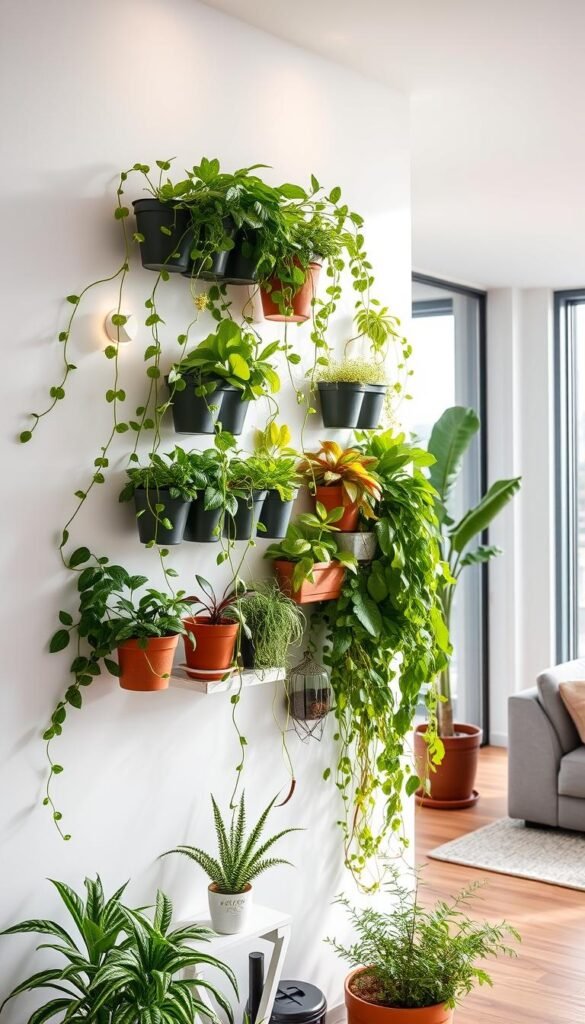Living in a compact home doesn’t mean you can’t enjoy fresh greenery. Imagine turning blank walls into lush, living art that breathes life into your space. This approach lets you grow herbs, flowers, or succulents without sacrificing precious square footage. It’s perfect for renters, city dwellers, or anyone craving nature indoors.
Why choose this method? Vertical setups use untapped wall areas, keeping floors clear while adding visual interest. You’ll spend less time bending over to weed or water. Better airflow around plants means fewer pests and healthier growth. Plus, harvesting becomes as simple as reaching up.
This guide walks you through creating your own green oasis. You’ll learn budget-friendly materials, simple assembly steps, and creative layouts. Whether you’re a seasoned plant parent or a first-timer, these ideas adapt to any skill level. Let’s transform your home into a vibrant retreat that works as hard as you do.
Introduction to Vertical Wall Gardening for Compact Spaces
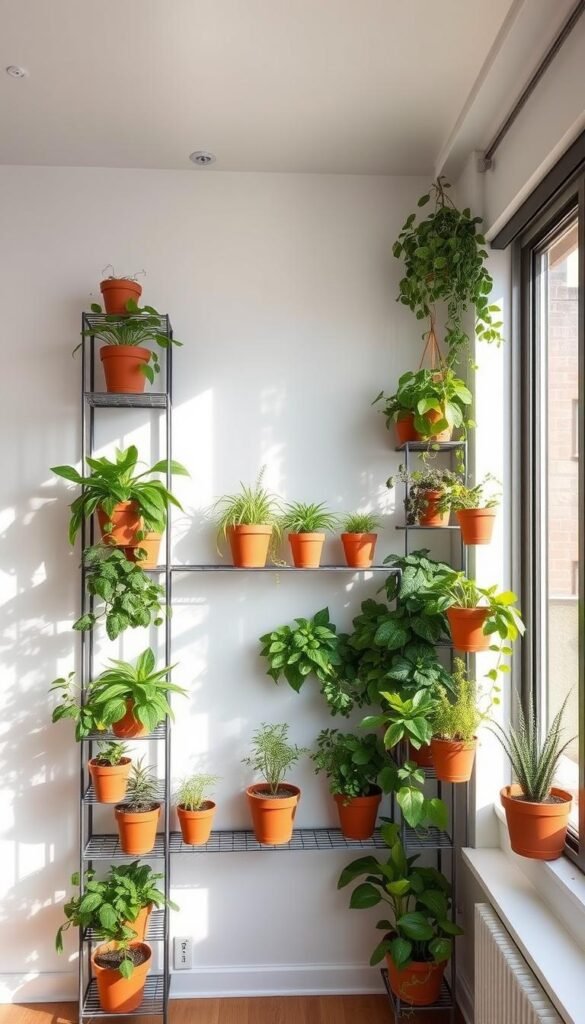
Urban residents are reimagining blank walls as vibrant plant displays. This innovative approach turns lifeless areas into living ecosystems, perfect for growing herbs, flowers, or leafy greens. It’s a fresh take on bringing nature indoors, especially where floor space feels scarce.
Setting the Stage for Urban Gardening
Why are city dwellers embracing this trend? Limited square footage pushes creativity upward. Walls offer untapped potential for greenery without cluttering countertops. You can cultivate fresh basil for pasta nights or arrange cascading vines for visual drama—all while keeping floors open.
Starting is simpler than you think. Many systems use lightweight pockets, modular panels, or repurposed shelves. Even beginners can create vertical setups with basic tools. Need inspiration? Explore creative layouts that blend functionality with artistry.
Here’s what makes wall-based gardening thrive:
- Improved air quality from indoor plants
- Quick access to ingredients for cooking
- Customizable designs to match your décor
This guide will walk you through plant selection, budget-friendly materials, and maintenance tricks. Whether you’re crafting a petite herb garden or a full-wall jungle, these ideas adapt to your lifestyle. Let’s turn those empty walls into your personal oasis.
The Growing Popularity of Vertical Gardening
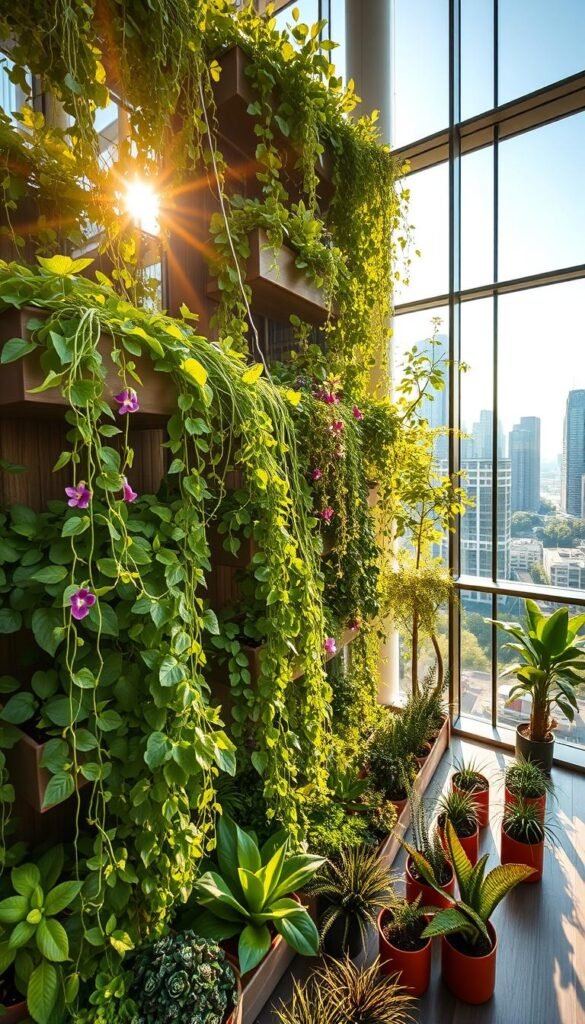
As cities grow taller, so do their gardens. Over 67% of U.S. households now grow plants indoors, with vertical setups leading the charge. This method isn’t just for concrete jungles—suburban homes also use it to maximize patios and balconies.
Why the surge? Busy schedules demand low-maintenance gardening ideas that fit modern life. Renters love how removable systems let them personalize spaces without permanent changes. Families use these living walls to teach kids about sustainability while saving room for play areas.
| Aspect | Traditional Gardens | Vertical Gardens |
|---|---|---|
| Space Needed | 10+ sq ft | 2-4 sq ft |
| Pest Issues | Common | Reduced by elevation |
| Harvest Access | Bending/kneeling | Eye-level picking |
| Airflow | Variable | Consistent circulation |
Urban cafes showcase edible vertical gardens for fresh ingredients. One Brooklyn restaurant grows 80% of its herbs on a single wall. Homeowners report cleaner air and 30% fewer allergy symptoms after installing green panels.
Ready to try it yourself? Later sections break down materials and step-by-step setups. You’ll learn how to match plants to your light conditions and create a thriving ecosystem that works with your routine.
DIY Vertical Wall Garden: Space-Saving Decor for Small Apartments
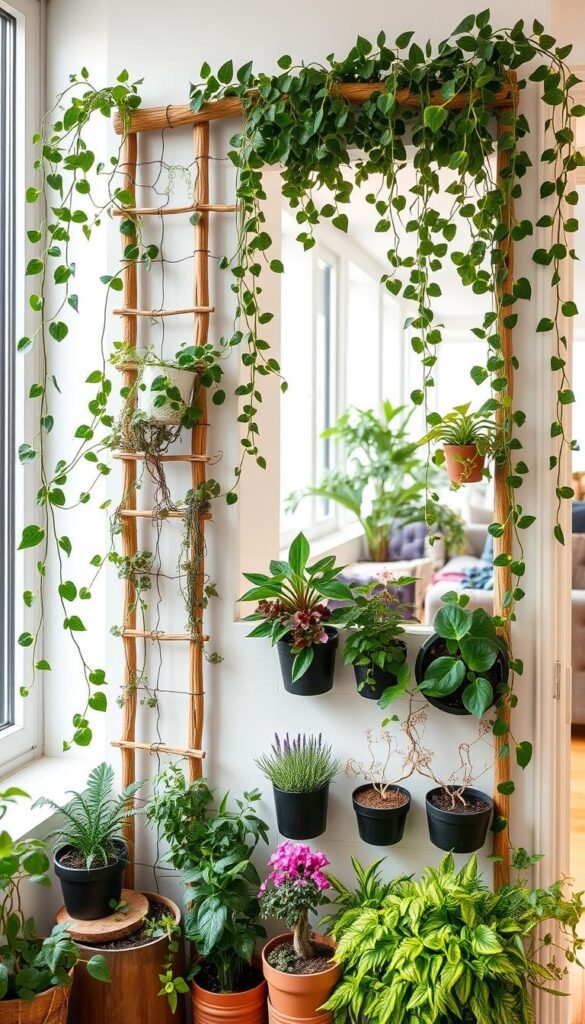
Transforming your living area into a green haven starts with smart use of overlooked spaces. A handcrafted plant display lets you merge creativity with functionality—no professional skills required. Repurposing everyday items like old shelves or fabric pockets keeps costs low while reducing waste.
Why buy new when you can upcycle? Metal gutters become sleek herb planters, while reclaimed wood transforms into rustic frames. These projects often take under $20 to complete. You’ll give discarded materials new purpose while adding personality to your rooms.
See how eco-friendly choices stack up against traditional options:
| Material Type | Cost | Eco-Impact | Ease of Use |
|---|---|---|---|
| Reclaimed Wood | $0-$10 | High | Moderate |
| Plastic Bottles | Free | Medium | Easy |
| Metal Gutters | $15-$30 | Medium | Hard |
| Fabric Pockets | $5-$12 | Low | Very Easy |
This approach does double duty. Your creation becomes both living decor and a fresh ingredient source. Imagine plucking basil for dinner from a vibrant wall arrangement. Even better—these installations protect walls better than heavy artwork when properly sealed.
Ready to build? Next, we’ll explore material lists tailored for tight budgets and unique layouts. You’ll learn how to choose plants that thrive in your specific light conditions and master simple assembly techniques. Let’s turn those bare walls into your favorite feature.
Essential Materials and Tools for Your Vertical Garden
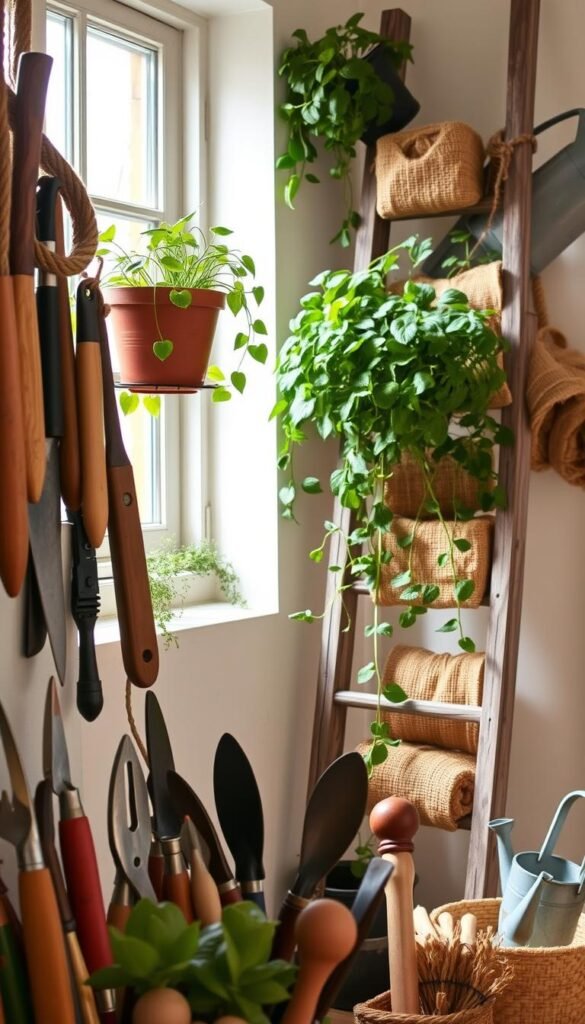
Building a thriving green wall starts with smart material choices. You’ll need lightweight pots, sturdy supports, and creative solutions that match your space. Focus on durable options that handle moisture while blending with your décor.
Selecting the Right Planters and Containers
Look for shallow pots or fabric pockets that fit your wall’s dimensions. Plastic and resin planters work well for herbs, while metal troughs suit trailing vines. Ensure each container has drainage holes to prevent root rot. Measure twice—overcrowded vertical gardens limit plant growth.
Choosing Wood, Wire, and Upcycled Materials
Reclaimed wood adds rustic charm and costs less than new lumber. Pair it with wire mesh for flexible plant arrangements. Old gutters or bottles become eco-friendly materials with personality. These choices reduce waste while creating unique textures.
| Material | Best Use | Benefits |
|---|---|---|
| Reclaimed Wood | Structural Frames | Weather-resistant, stylish |
| Galvanized Wire | Climbing Supports | Promotes airflow |
| Plastic Bottles | Herb Planters | Lightweight, free |
Secure heavy structures with wall anchors, and seal wood to protect surfaces. Test weight limits before hanging—safety matters as much as style. With the right materials, your living wall becomes a lasting feature that grows with your needs.
A Step-by-Step Guide to Building Your Vertical Garden
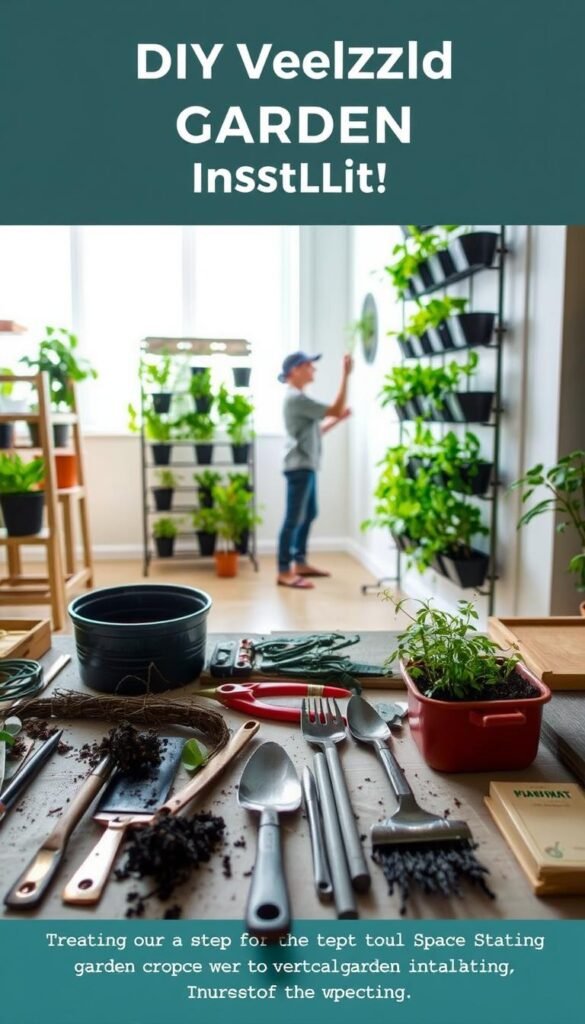
Ready to turn that empty wall into a thriving plant display? Start by mapping your space like a pro. Measure the area’s width and height, noting sunlight patterns throughout the day. Mark spots near windows for sun-loving greens and shadier zones for ferns.
Planning Your Space and Layout
Sketch your design using grid paper or a free app. Arrange containers in staggered rows for better light exposure. Leave 6-8 inches between vertical garden sections—crowded plants compete for resources. Test layouts by taping paper cutouts to the wall before drilling.
Consider these factors when choosing your setup:
| Hanging Method | Best For | Tools Needed | Weight Capacity |
|---|---|---|---|
| Wall Anchors | Heavy Wood Frames | Drill, Level | 50+ lbs |
| Adhesive Hooks | Light Fabric Pockets | Measuring Tape | 5-10 lbs |
| Tension Rods | Rental-Friendly Setups | Adjustable Rod | 15-20 lbs |
Installing the Structure and Hanging Options
Secure your frame or trellis using corrosion-resistant screws. For brick walls, use masonry bits and plastic anchors. Add a waterproof backing layer if mounting directly on drywall. This protects surfaces from moisture while creating a clean look.
Hang planters starting from the bottom—it’s easier to adjust as you build upward. Use carabiners or S-hooks for flexible arrangements. Test each row’s stability by gently tugging before adding soil. This way, you catch weak points early.
Finish by labeling plants with waterproof tags. Rotate containers weekly so all greens get equal light. Your living wall will thrive when planned with care from the start.
Top Plant Choices for a Lush Vertical Garden
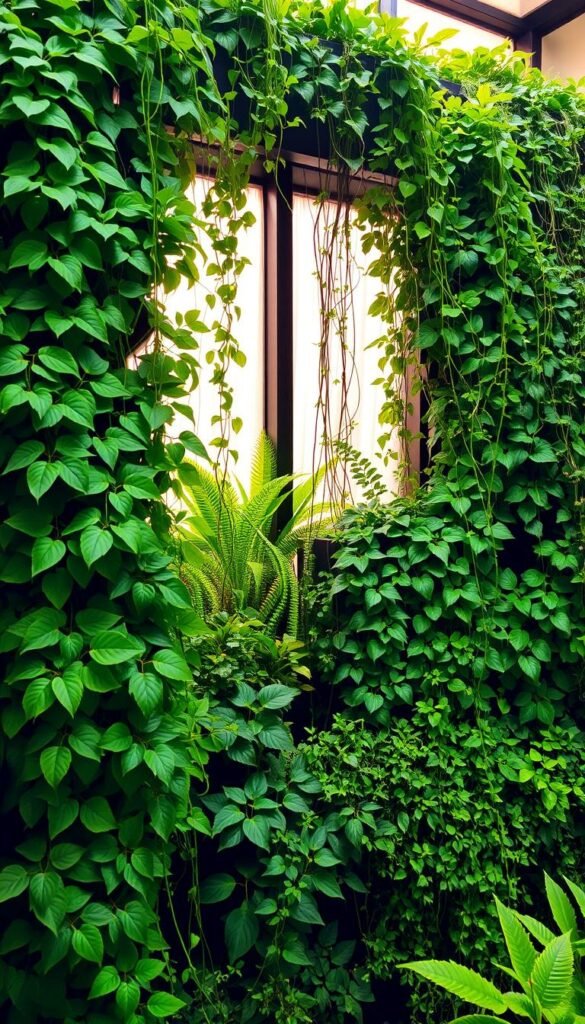
Choosing the right greenery transforms your setup from basic to breathtaking. Focus on species that grow upward or cascade naturally. These picks thrive in confined spaces while delivering visual impact and practical benefits.
Edible Stars That Reach for the Sky
Climbing vegetables and herbs maximize your harvest without hogging floor space. Pole beans shoot up trellises, yielding pounds of produce. Compact cherry tomato varieties flourish in hanging planters with proper support. Basil and mint grow vigorously in shallow containers, their aromatic leaves perfect for kitchen use.
Consider these top performers for edible walls:
| Plant | Light Needs | Growth Tip |
|---|---|---|
| Pole Beans | 6-8 hours sun | Use twine guides |
| Dwarf Tomatoes | 4-6 hours sun | Prune suckers |
| Strawberries | 5+ hours sun | Hanging baskets |
Pair these with thyme or oregano for a pizza-ready garden. Just ensure your structure can handle mature plant weight.
Blooming Beauties for Sensory Appeal
Flowering plants turn functional walls into living art. Trailing petunias spill color for months, while compact begonias thrive in shade. Fragrant jasmine or sweet peas add perfume near seating areas. These blooms attract pollinators if placed near windows.
Top picks for color and scent:
- Nasturtiums: Edible flowers + pest resistance
- Fuchsia: Dramatic blooms for shady spots
- Pansies: Cold-tolerant color bursts
Mix flowering varieties with herbs for texture contrast. Rotate seasonal blooms to keep your display fresh year-round. Always match plant needs to your available light—south-facing walls suit sun lovers, while north-facing ones host ferns.
Design Ideas and Creative Inspirations
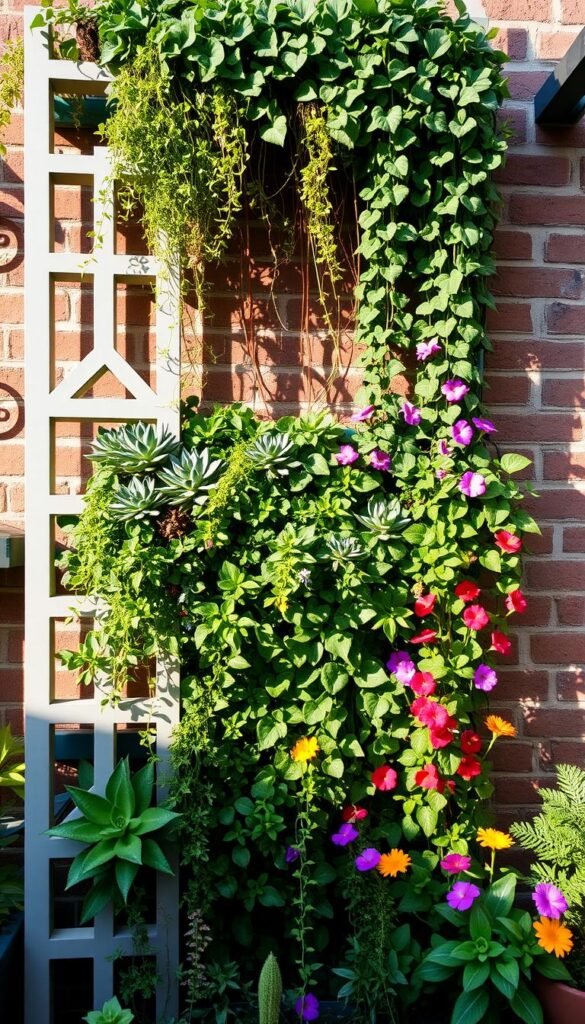
Your blank walls hold untapped potential for living masterpieces. Move beyond basic setups with design ideas that merge artistry with botany. Picture hexagonal planters forming honeycomb patterns or mason jars suspended in geometric arrangements. These vertical gardening ideas turn functional spaces into conversation starters.
Repurpose household items for unexpected charm. Old colanders become quirky herb displays, while fabric shoe organizers transform into cascading succulent walls. These garden ideas cost almost nothing but deliver maximum personality. Mix materials like copper pipes and reclaimed wood for industrial-rustic fusion.
Try modular systems for adaptable layouts. Magnetic planters let you rearrange greens like living puzzle pieces. For tight corners, use triangular shelves that hug walls—perfect ideas small spaces adore. Rotate seasonal blooms or edible plants to keep your display dynamic.
Style your green feature as intentional décor. Match planter colors to accent pillows or blend trailing vines with curtain textures. Cluster plants in odd numbers for visual balance. These design ideas prove functionality and beauty coexist effortlessly.
Your wall’s personality should reflect yours. Whether crafting a minimalist monochrome display or a wild jungle collage, these ideas adapt to any aesthetic. Start small with three connected pots, then expand as confidence grows. Your living canvas awaits.
Indoor Setups Perfect for Small Apartments
Light becomes your secret weapon when growing greenery indoors. Position your setup near east-facing windows for gentle morning sun that fuels growth without scorching leaves. South-facing spots work too, but use sheer curtains to filter intense afternoon rays.
Optimizing Natural and Artificial Lighting
Track sunlight patterns for 3 days using a free app like Light Meter. Mark areas getting 4+ hours of indirect light—ideal for herbs like mint or parsley. Dark corners? Install full-spectrum LED strips 6 inches above plants. They mimic daylight while saving energy.
Try this lighting combo for thriving indoor plants:
| Light Source | Best For | Daily Duration |
|---|---|---|
| East Window | Leafy Greens | 6 hours |
| LED Grow Lights | Flowering Plants | 12 hours |
| North Window | Ferns | 4 hours |
Rotate planters weekly so all sides get equal exposure. In studio apartments, hang setups between living and dining areas—they act as natural room dividers. Pair with mirrors to bounce light deeper into your space.
Struggling with low-light areas? Snake plants and pothos thrive there while helping improve air quality. Start with easy-care varieties while learning your apartment’s light personality. Remember, proper container choices boost plant health as much as lighting does.
Your green wall does double duty—purifying air while softening hard surfaces. With smart placement and light tweaks, even windowless halls can host vibrant displays. Now breathe deep and watch your indoor oasis flourish.
Maintenance Tips for a Healthy Vertical Garden
Keeping your green wall thriving requires smart routines tailored to its unique needs. Elevated setups dry faster than traditional gardens, demanding precise watering and nutrient plans. With the right approach, you’ll enjoy lush growth while minimizing upkeep time.
Smart Hydration and Nutrient Management
Check soil moisture daily by pressing a finger an inch deep. If it feels dry, water until liquid drains from the bottom—but avoid soggy roots. Morning sessions reduce evaporation, while evening watering risks fungal issues.
Simplify care with these tools:
| Method | Best For | Frequency | Benefits |
|---|---|---|---|
| Manual Watering | Small setups | Every 2 days | Precise control |
| Drip Systems | Large walls | 30 mins daily | Consistent moisture |
| Self-Watering Planters | Busy schedules | Weekly refills | Prevents overflows |
Feed plants every 3-4 weeks with a balanced 10-10-10 fertilizer. Mix liquid formulas into your water for even distribution. Slow-release pellets work well in fabric pockets, feeding roots gradually.
Rotate planters monthly to ensure equal light exposure. Wipe leaves with a damp cloth to boost photosynthesis. Spot pests early by inspecting undersides—neem oil tackles most invaders without harsh chemicals.
Consistent care unlocks the full benefits of your living wall, from cleaner air to fresh herbs. For deeper insights, explore this complete vertical garden guide. New to container care? Master the basics with this step-by-step starter resource.
Troubleshooting Common Vertical Gardening Challenges
Even the most carefully planned green walls can hit snags—here’s how to fix them fast. From wobbly frames to yellowing leaves, these issues are fixable with simple tweaks. Let’s tackle the top headaches and their smart solutions.
Shaky structures? Reinforce mounts with toggle bolts if drilling into drywall. For brick surfaces, use masonry anchors rated for twice your setup’s weight. Check connections monthly—tighten loose screws before plants grow heavy.
Spot tiny holes in leaves or sticky residue? Mix 1 tsp dish soap with 1 quart water and spray affected areas. For stubborn pests, wipe stems with cotton swabs dipped in rubbing alcohol. Prevent future invasions by quarantining new plants for a week.
| Issue | Quick Fix | Prevention Tip |
|---|---|---|
| Poor Drainage | Add gravel layer | Use pots with holes |
| Uneven Growth | Rotate weekly | Install reflectors |
| Mold | Increase airflow | Water at soil level |
Plants looking sad? Check roots for overcrowding—divide them if they’ve outgrown containers. If sourcing plants from a yard or nursery, inspect for diseases before introducing them to your wall. Yellow foliage often signals overwatering; let soil dry completely between sessions.
Remember, troubleshooting is part of the journey. Each solution makes your green space more resilient. Keep notes on what works—your future self will thank you when expanding to new walls or ground planters!
Maximizing Space and Enhancing Decor in Your Apartment
Your living area becomes a canvas where greenery meets personal style. Blend functionality with artistry by turning overlooked nooks into vibrant displays. Even narrow walls can host lively arrangements that reflect your taste while optimizing room flow.
Breathing New Life Into Forgotten Items
Upcycling transforms ordinary objects into plant homes with character. Old picture frames become succulent displays when lined with moss. Wooden crates stack into modular planters that double as room dividers. These projects add unique textures while keeping materials out of landfills.
Try these creative conversions for your setup:
| Material | New Purpose | Style Boost |
|---|---|---|
| Vintage Tins | Herb Containers | Retro Kitchen Charm |
| Ladder Shelves | Tiered Plant Stand | Farmhouse Flair |
| Fabric Scraps | Hanging Pockets | Bohemian Accent |
Match your planters to existing décor for a cohesive look. Paint metal cans to mimic accent pillows or stain wood to complement furniture. These touches make your greenery feel intentional, not cluttered.
Rotate seasonal blooms near seating areas for fresh energy. Use trailing ivy to frame windows or mirrors. Every choice should serve both beauty and purpose—your home deserves nothing less.
Expert Vertical Gardening Ideas and Innovations
Elevate your plant displays with designs that go beyond basic setups. Modern growers are blending practical structures with artistic flair, creating living installations that wow guests while boosting yields. Let’s explore how trellis systems and reclaimed materials can transform your approach.
Creative Structures That Work Harder
Think of trellises as multi-purpose tools. A well-placed grid supports climbing cucumbers while doubling as a room divider. Try trellis using geometric patterns—hexagons or diamonds add visual rhythm. Pair metal frames with wooden accents for industrial-chic contrast.
Pallet gardens bring rustic charm without the cost. Staple landscape fabric to the back, fill slats with soil, and tuck in herbs or succulents. These upcycled wonders thrive on balconies or as kitchen accents. Best part? They’re lightweight enough to rearrange seasonally.
| Trellis Type | Best Plants | Style Impact |
|---|---|---|
| Expandable Metal | Peas, Beans | Modern Minimalist |
| Bamboo Grid | Passionflower, Ivy | Zen Garden |
| Repurposed Ladder | Cherry Tomatoes | Farmhouse Vintage |
Combine systems for dynamic results. Layer a pallet base with vertical trellises to create depth. Mix edible vines with flowering species—nasturtiums climb while peppering salads with color. This approach maximizes space while creating microclimates that help plants thrive.
Looking ahead, designers are experimenting with vertical gardening tech. Smart irrigation sensors and modular magnetic planters let you customize layouts daily. These innovations prove that growing upward isn’t just practical—it’s the future of urban cultivation.
Bringing It All Together in Your Urban Oasis
Your journey to a greener home starts with simple choices. By combining smart layouts, sturdy materials, and the right plants, you’ve seen how even tight corners can flourish. Whether using a garden trellis for climbing greens or repurposing everyday items, creativity unlocks endless possibilities.
Remember: successful setups balance beauty and practicality. Mix trailing vines with compact herbs for texture. Rotate sun-loving plants toward light sources. Water wisely—moisture needs change with seasons. These small steps add up to thriving displays that refresh your space and mood.
Ready to transform blank walls? Start with one shelf or pocket planter. Experiment with garden ideas that match your style—geometric patterns, rustic wood, or modern metals. Share photos of your progress; every thriving leaf proves urban gardening works wonders.
Your oasis awaits. Grab those tools, pick your favorite greens, and build the best vertical setup for your lifestyle. Breathe deeper, cook fresher, and watch your walls come alive. Let’s grow upward together!

